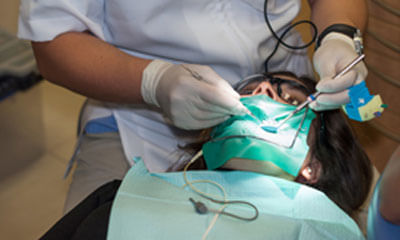Get the App
For Doctors
Login/Sign-up
Last Updated: Aug 29, 2019
BookMark
Report
Flossing & Brushing
Flossing
Flossing removes plaque and bacteria that you cannot reach with your toothbrush. If you don't floss, you are missing more than one-third of your tooth surface. Plaque is the main cause of gum disease. It is an invisible bacterial film that develops on your teeth every day.
Within 24 to 36 hours, plaque hardens into tartar (also called calculus), which can only be removed by professional cleaning. Floss at least once a day, and plaque never gets the chance to harden into tartar. Getting into the habit of daily flossing is easier when you floss while doing something else like watching tv or listening to music, for example.
How to floss your teeth
Step 1
Take a length of floss equal to the distance from your hand to your shoulder.
Take a length of floss equal to the distance from your hand to your shoulder
Wrap it around your index and middle fingers, leaving about two inches between your hands.
Wrap it around your index and middle fingers, leaving about two inches between your hands
Step 2
Slide the floss between your teeth and wrap it into a" c" shape around the base of the tooth and gently under the gumline. Wipe the tooth from base to tip two or three times.
Slide the floss between your teeth and wrap it into a
Step 3
Be sure to floss both sides of every tooth. Don't forget the backs of your last molars. Go to a new section of the floss as it wears and picks up particles.
Step 4
Brush your teeth after you floss - it is a more effective method of preventing tooth decay and gum disease.
Brush your teeth after you floss - it is a more effective method of preventing tooth decay and gum disease
Flossing problems and solutions
Gums sometimes bleed when you first begin to floss. Bleeding usually stops after a few days. If bleeding does not stop, see your dentist. Floss can shred if you snag it on an old filling or on the ragged edge of a tooth.
Try another type of floss or dental tape. Ask your dentist or dental hygienist for advice. If your floss still shreds, see your dentist.
Brushing
Regular, thorough brushing is a very important step in preventing tooth decay and gum disease. Brushing removes the bacteria that promote tooth decay and the plaque that can cause gum disease.
Ideally, you should brush after every meal, because the bacterial attack on teeth begins minutes after eating. At the very least, brush once a day and always before you go to bed. Brushing your teeth isn't complicated, but there is a right and a wrong way.
How to brush your teeth
Step 1
Brush at a 45 degree angle to your teeth. Direct the bristles to where your gums and teeth meet. Use a gentle, circular, massaging motion, up and down. Don't scrub. Gums that recede visibly are often a result of years of brushing too hard.
Brush at a 45 degree angle to your teeth. Direct the bristles to where your gums and teeth meet. Use a gentle, circular, massaging motion, up and down. Don't scrub. Gums that recede visibly are often a result of years of brushing too hard
Step 2
Clean every surface of every tooth. The chewing surface, the cheek side, and the tongue side.
Step 3
Don't rush your brush. A thorough brushing should take at least two to three minutes. Try timing yourself.
Don't rush your brush. A thorough brushing should take at least two to three minutes. Try timing yourself
Step 4
Change your usual brushing pattern. Most people brush their teeth the same way all the time. That means they miss the same spots all the time. Try reversing your usual pattern.
Change your usual brushing pattern. Most people brush their teeth the same way all the time. That means they miss the same spots all the time. Try reversing your usual pattern
Step 5
Use a soft brush with rounded bristles. The right toothbrush cleans better. Choose a size and shape that allow you to reach all the way to your back teeth. There are many different types of brushes, so ask your dentist to suggest the best one for you. Dentists recommends you replace your toothbrush every three months.
Flossing removes plaque and bacteria that you cannot reach with your toothbrush. If you don't floss, you are missing more than one-third of your tooth surface. Plaque is the main cause of gum disease. It is an invisible bacterial film that develops on your teeth every day.
Within 24 to 36 hours, plaque hardens into tartar (also called calculus), which can only be removed by professional cleaning. Floss at least once a day, and plaque never gets the chance to harden into tartar. Getting into the habit of daily flossing is easier when you floss while doing something else like watching tv or listening to music, for example.
How to floss your teeth
Step 1
Take a length of floss equal to the distance from your hand to your shoulder.
Take a length of floss equal to the distance from your hand to your shoulder
Wrap it around your index and middle fingers, leaving about two inches between your hands.
Wrap it around your index and middle fingers, leaving about two inches between your hands
Step 2
Slide the floss between your teeth and wrap it into a" c" shape around the base of the tooth and gently under the gumline. Wipe the tooth from base to tip two or three times.
Slide the floss between your teeth and wrap it into a
Step 3
Be sure to floss both sides of every tooth. Don't forget the backs of your last molars. Go to a new section of the floss as it wears and picks up particles.
Step 4
Brush your teeth after you floss - it is a more effective method of preventing tooth decay and gum disease.
Brush your teeth after you floss - it is a more effective method of preventing tooth decay and gum disease
Flossing problems and solutions
Gums sometimes bleed when you first begin to floss. Bleeding usually stops after a few days. If bleeding does not stop, see your dentist. Floss can shred if you snag it on an old filling or on the ragged edge of a tooth.
Try another type of floss or dental tape. Ask your dentist or dental hygienist for advice. If your floss still shreds, see your dentist.
Brushing
Regular, thorough brushing is a very important step in preventing tooth decay and gum disease. Brushing removes the bacteria that promote tooth decay and the plaque that can cause gum disease.
Ideally, you should brush after every meal, because the bacterial attack on teeth begins minutes after eating. At the very least, brush once a day and always before you go to bed. Brushing your teeth isn't complicated, but there is a right and a wrong way.
How to brush your teeth
Step 1
Brush at a 45 degree angle to your teeth. Direct the bristles to where your gums and teeth meet. Use a gentle, circular, massaging motion, up and down. Don't scrub. Gums that recede visibly are often a result of years of brushing too hard.
Brush at a 45 degree angle to your teeth. Direct the bristles to where your gums and teeth meet. Use a gentle, circular, massaging motion, up and down. Don't scrub. Gums that recede visibly are often a result of years of brushing too hard
Step 2
Clean every surface of every tooth. The chewing surface, the cheek side, and the tongue side.
Step 3
Don't rush your brush. A thorough brushing should take at least two to three minutes. Try timing yourself.
Don't rush your brush. A thorough brushing should take at least two to three minutes. Try timing yourself
Step 4
Change your usual brushing pattern. Most people brush their teeth the same way all the time. That means they miss the same spots all the time. Try reversing your usual pattern.
Change your usual brushing pattern. Most people brush their teeth the same way all the time. That means they miss the same spots all the time. Try reversing your usual pattern
Step 5
Use a soft brush with rounded bristles. The right toothbrush cleans better. Choose a size and shape that allow you to reach all the way to your back teeth. There are many different types of brushes, so ask your dentist to suggest the best one for you. Dentists recommends you replace your toothbrush every three months.



+1.svg)
